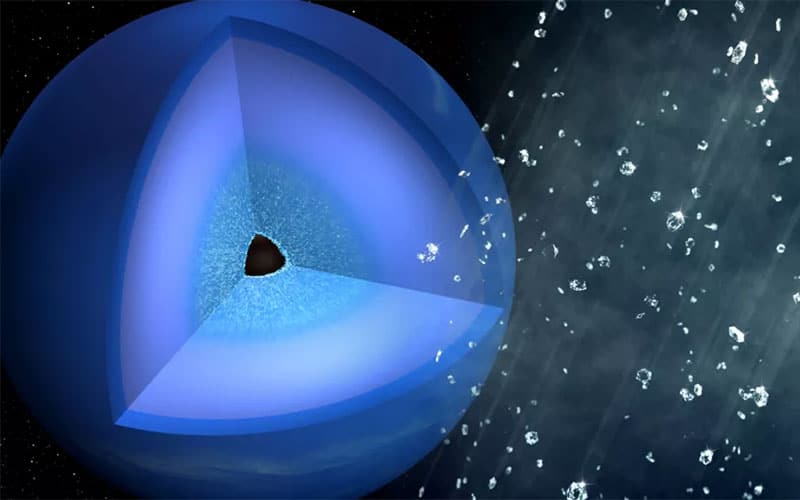Astronomers call Neptune and Uranus “Ice Giants.” How appropriate, then, that the 7th and 8th planets most distant from our sun may be under a constant deluge of diamond rain?
Images of Neptune

Uranus and Neptune are primarily composed of hot, dense clouds of water, ammonia and methane. The outermost layers are around 3,000 degrees Fahrenheit (1,700 C) and have atmospheric pressure around 200,000 times that of Earth. The deeper into the planet you go the hotter and denser things become. We believe, at the center of these worlds, there are hard, rocky cores, where the temperatures are estimated near 12,000 degrees Fahrenheit (6,700 degrees Celsius) and pressures around 6 million times that of Earth’s atmosphere.
Carbon Creation!
In such hot and dense conditions the state of these elements can undergo change. Methane, in particular, is of interest here. Methane’s chemical formula is CH4, which represents one carbon atom bonded to four hydrogen atoms. Within the clouds of these ice giants, methane molecules can creak apart, releasing that carbon atom. The atom will then finds others, forming long chains which ultimately squeeze together (heat and pressure, you know…) and form crystallize patterns like (here it comes…) diamonds.

The diamond formations are denser than the surrounding elements so they drop through the mantle’s layers. Most ultimately become vaporized by the intense heat, at which point they float back up to areas of less pressure – and repeat the cycle. A constant rain of diamonds spanning these two giant, icy worlds. It’s hypothesized that, over millennia, their cores could even be coated by a thick layer of diamonds.
According to the team at SLAC (Stanford Linear Accelerator):
Researchers simulated the environment found inside these planets by creating shock waves in plastic with an intense optical laser at the Matter in Extreme Conditions (MEC) instrument at SLAC National Accelerator Laboratory’s X-ray free-electron laser, the Linac Coherent Light Source (LCLS). SLAC is one of 10 Department of Energy (DOE) Office of Science laboratories.
In the experiment, the scientists were able to see that nearly every carbon atom of the original plastic was incorporated into small diamond structures up to a few nanometers wide. On Uranus and Neptune, the study authors predict that diamonds would become much larger, maybe millions of carats in weight. Researchers also think it’s possible that over thousands of years, the diamonds slowly sink through the planets’ ice layers and assemble into a thick layer around the core.




